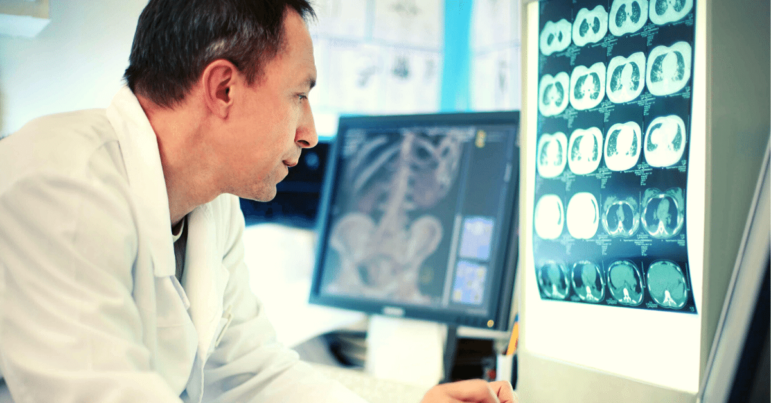By Dr. Joseph Fraiman
I am an emergency physician working in the bayou communities around New Orleans, Louisiana. On each of my last four shifts I have been the first doctor to identify a case of Covid-19 in the community I was working in, even as state and federal agencies denied my requests for testing. But I am no genius. Here’s what I figured out from reading the studies.
In China, doctors quickly saw the swab test wasn’t good enough. All tests have strengths and weaknesses, and the ‘reverse transcription-polymerase chain reaction, or PCR swab, is correct 99% of the time—if it finds Covid-19. But the swab’s weakness is low sensitivity. Only about 50-80% of those with Covid-19 infection will be identified by the RT-PCR test. In other words, it misses up to half of people with the disease. Recognizing this potentially fatal flaw, and seeing limited supplies of the swab test, doctors and fever clinics in China began performing computed tomography, or CT scans of the lungs, on all possible cases. This led to crucial research and a surprising discovery: CT scans found the disease more than swab testing did.
A recent piece by Dr. Michael Hope and colleagues in The Lancet urged doctors not to rely on CT testing for COVID-19, arguing that patients with suspected Covid-19 infection should be isolated until their diagnosis is confirmed with PCR testing, whether or not they get a CT scan. However, without a diagnosis, many people will be pressured to keep working, especially if they do not have paid sick leave or if they live paycheck to paycheck.
Given the extreme scarcity of PCR tests on the ground, using CT scans has helped guide care for patients with Covid-19 symptoms, and has helped us get the PCR tests patients need. For example, last month I treated a 27-year old woman diagnosed by her doctor with pneumonia. After five days of antibiotics she was worse, and her chest x-ray and blood tests were consistent with Covid-19. I called the health department. Based on federal guidelines they refused to test. When I called them an hour later with a CT scan showing clear evidence of Covid-19 they took it seriously, did the test, and (five days later) confirmed the region’s first case. Meanwhile we had admitted, isolated, and treated our patient for Covid-19.
In China, while the swab was routinely missing cases of Covid, a CT scan often found it. In other words, CT scans are more sensitive than the swab. (Chillingly, my nurses told me of a case the day before where a CT scan showed Covid-19 findings, but the patient was released when a swab was negative). Signature findings like ‘ground glass opacities’, for instance, accurately detected Covid-19. Were there false positives? Yes, because other lung ailments also show such findings. But when the scans suggested Covid-19 they were right far more than wrong. And in a pandemic where isolation is key, the Chinese doctors recognized an ideal test should overcall, not undercall, the disease.
Better yet, CT scans offer an immediate answer, typically in a time window of peaking signs and symptoms—i.e. when the patient is most likely to be spreading the disease. Identifying infections five days earlier could save countless lives by ensuring timely isolation and treatment.
We have the CT scanners and training to accurately identify Covid-19 cases, but instead of using them we are panicking about the lack of swabs. We are still weeks from broadly available, rapid swab testing, and then we’ll still be using a test that misses up to half of cases. It is time to shift gears, deal with the situation as it is. We need to ramp up CT scan testing like China did, use the tools at hand to catch up with viral reality on the ground.
We must be nimble in capitalizing on published evidence from areas that have turned a corner. With a near-zero new infection rate China is showing us the way. It may feel strange for most healthcare providers to implement information this hot off the presses, but there is no mystery here. We dropped the ball, not absorbing and operationalizing the rolling lessons of Covid-19. China, Singapore, Japan, and South Korea are leading by example, and to prevent millions of American deaths we must follow.
The irony here is I am ordinarily a vocal opponent of CT scan overuse, which I believe plagues our health system. There are real downsides to using CT, like radiation exposure and cost. But the small, long term risk this represents does not begin to compare with the instant harms of releasing Covid-19 into the community and being blind to the cases around us.
It will be challenging. This approach means adapting CT scanner use to prioritize detection of Covid-19, and cleaning machines more thoroughly than normal. But China is no more inherently capable of scaling up CT scan use than we are.
It is unclear why the Centers for Disease Control and Prevention has failed to even acknowledge the importance of CT scanning for diagnosis in China. Given their silence most physicians in the U.S. seem unaware of the test’s rapid and reliable results. But China controlled the epidemic with wide-spread CT scanning and swab testing, even in mild cases. It works—I have seen it.
To stand any chance of controlling this disease the CDC needs to endorse an aggressive disease identification pathway that includes CT scanning for rapid identification and isolation. It is unacceptable to rely solely on a test that misses half of cases and takes days, when we have a better, faster test.
We could shave weeks off the invisible tidal wave of Covid-19. Let’s do it, today. Please.
Dr. Joseph Fraiman is an emergency medicine physician currently practicing at Thibodaux Regional Medical Center, Slidell Memorial Hospital, and Lallie Kemp Regional Medical Center in Louisiana.
